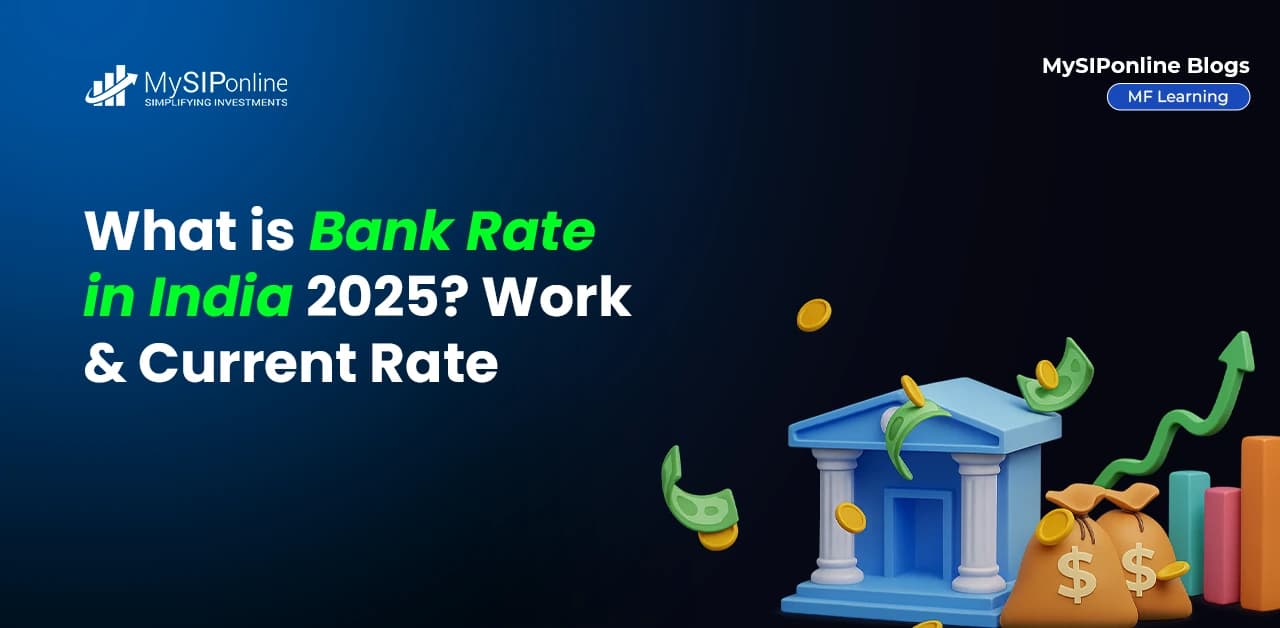Table of Contents
Did you know that even a small 0.25% change in the bank rate by the Reserve Bank of India (RBI) can affect your loan EMIs, business costs and even the country’s economic growth? This single rate affects inflation, interest rates and overall liquidity in economic growth.
But “What exactly is the bank rate and why does it matter so much?”
Interestingly, it is defined as the interest rate at which the RBI lends long-term funds to commercial banks without collateral and it influences loans, investments and even mutual fund SIP returns.
What is a Bank Rate?
In simple words, the bank rate is the interest rate at which the central bank, the Reserve Bank of India RBI lends money to commercial or domestic banks without any security and is commonly preferred for the long term.
Bank rate is also called the discount rate. Loans at the bank rate do not allow the sale & repurchase of securities.
RBI is like "Banks for Banks,” and bank rates are like a base or benchmark, so interest rates impact like charges applied to things such as loans and home mortgages. This is a major part of the RBI monetary policy.
In short, the bank rate directly affects lending rates, borrowing costs and overall investment activity in economic growth.
Pro Tip: Use a SIP Calculator to visualize your investment growth and set goals.
Now that we understand the bank rate, let us look at the bank rate determined.
How is a Bank Rate Determined?
Here are the major points showing how the bank rate is determined:
- The Monetary Policy Committee (MPC)of the RBI determines the bank rate in India and the Federal Open Market Committee (FOMC) in the U.S. During its policy review meetings of six members and in every two months.
- It takes several economic indicators, such as Inflation trends, economic growth, liquidity, global interest rate policies by the RBI, like the Federal Reserve Bank of Englandand other central banks, to use monetary policy to control inflation and keep the economy stable.
- When inflation rises, the bank rateis increased to reduce spending and bring prices under control. In contrast, during an economic crisis, the rate might be reduced to boost loans and investment.
- The present bank rate as of July 2025, in India, is 6.75%as of the RBI update. The rate shows the liquidity management & minimising inflationary pressure.
Do You Know: Banks borrowing from the Fed pay the discount rate, set by the Board of Governors, usually higher than the federal funds rate.
Let’s move to the next headline how bank rates work.
How Bank Rates Work in India?
To understand how bank rates, work in India, let’s break it down into simple points:
- Any changes in bank rates impact the entire banking and financial system. The bank ratehelps maintain the flow of money in the banking system, financial loan system, interest rates and the broader economy.
- When the RBI increases the bank rate, borrowing becomes costlier for commercial banks, resulting in higher loan rates, but it helps to reduce spending,mutual funds and SIP returns grow and investment with cooling inflation.
- On the other hand, a lower bank rate inspires commercial banks to borrow, improving liquidity, promoting economic investment growth.
Start today with a small amount of SIP on a regular interval, monthly, quarterly and annually.
Start Your SIP TodayLet your money work for you with the best SIP plans.
Why a Bank Might Need to Borrow
Banks sometimes face some sort of shortfall and need to borrow from the Reserve Bank of India (RBI). Here are the key reasons:
-
Surplus Needs
Banks borrow when funds are limited to meet the required reserves, such as CRR and SLR.
-
In Liquidity Crunch
A temporary liquidity limit caused by unexpected withdrawals or repayment delays may require borrowing.
-
High Lending Loans Disbursed
Without being affected by regular activities, banks can borrow to pay for big loans or corporate credit.
-
Buying in Government Securities
Banks may borrow money to fulfil their need to hold a particular quantity of government securities.
-
Day-to-Day Activities
Banks may require short-term funding for interchange payments, communities, or financial management.
Pro Tip: Get instant, easy & simple calculations using the SWP Calculator in Seconds.
Smart Investments, Bigger Returns
Now, explore the types of bank rates in the next headline.
Types of Bank Rates
Here are the various types of bank rates:
- Discount Rate: The rate at which the RBI gives long-term loans to banks without securities or assets. It sets the base for loan interest rates.
- Repo Rate: In this, it is the short-term borrowing where banks sell government bonds to the RBI and buy them back later.
- Reverse Repo Rate: The rate at which the RBI carries off money from banks to absorb extra cash and control inflation.
- Primary Credit Rate: Used in some countries, like in the US, the rate for lending strong and stable banks.
- Seasonal Credit Rate: Given to banks during seasonal ups and downs, like in farming or tourism areas.
- Base Rate/ Minimum Lending Rate: The low rate at which banks can lend money to customers.
Also Read: Top investment banking companies in India: whom you trust?
Now, to clear confusion, here’s how the bank rate differs from the repo rate.
Difference between Bank Rate VS Repo Rates
The table below draws a difference between the bank rate and repo rate in detail:
| Parameter | Bank Rate | Repo Rate |
|---|---|---|
| Definition | The rate at which the RBI lends long-term funds to banks without collateral. | The rate at which the RBI lends short-term funds to banks using collateral. |
| Collateral | No collateral required. | Requires collateral (usually government securities/bonds) |
| Purpose | Controls long-term lending rates and borrowing costs. | Manages short-term liquidity and cash flow in the banking system. |
| Impact on Banks | Directly affects banks' overall lending rates and long-term funds. | Mainly influences short-term borrowing and lending operations. |
| Rate Level | Usually higher than the repo rate. | Usually lower than the bank rate. |
| Current Rate (2025) | 6.75% (as of July 2025) | 6.50% (as of July 2025) |
This brings us to the next important point impact of bank rates
Impact of the Bank Rate
The bank rate directly affects businesses, consumers and even investments like mutual funds and SIP. Here is how it impacts different aspects of the economy:
- Loans
A higher bank rate makes home, personal and business loans expensive and a lower rate makes them cheaper. - Spending
High rates reduce consumer spending& boost demand for goods and services. - Investments
Higher rates reduce liquidity, so investors shift to FDs, lowering inflows into mutual funds and SIPs. - Markets
Rising rates lower bond pricesand can affect mutual fund NAVs, especially debt funds. - Economy
High bank rates control inflation but slow down economic growthand risk inflation.
Pro Tip: Find risk & growth of MF in seconds with the Mutual Funds Screener.
Conclusion
To sum up, the bank rate is one of the major tools in the RBI’s monetary policy community. It not only holds commercial banks, but also loans, savings accounts, investment decisions and the broader economic growth of India.
As of 2025, with the current bank rate of 6.75%, the RBI aims to balance inflation control and growth. Keeping an eye on bank rate actions can help individuals, businesses and investors make informed financial decisions.
Frequently Asked Questions
1. How does the Bank Rate affect loans and EMIs?
When the bank rate increases, banks raise their lending rates, making loans & EMIs costlier, while a lower bank rate makes borrowing cheaper.
2. Who decides the Bank Rate in India?
The Reserve Bank of India RBI decides and updates the bank rate during its Monetary Policy Committee MPC meetings.
3. How does the Bank Rate impact mutual funds and SIPs?
Higher bank rates reduce liquidity and may lower inflows into mutual funds and SIPs and affecting returns.
4. Why is the Bank Rate important for the economy?
It controls inflation, manages liquidity in the banking system, and influences overall economic growth by impacting borrowing costs.
5. Does the Bank Rate affect savings account interest?
Yes, at the time of bank rate changes, banks adjust their savings account and deposit interest rates accordingly.











(1).webp&w=3840&q=75)



